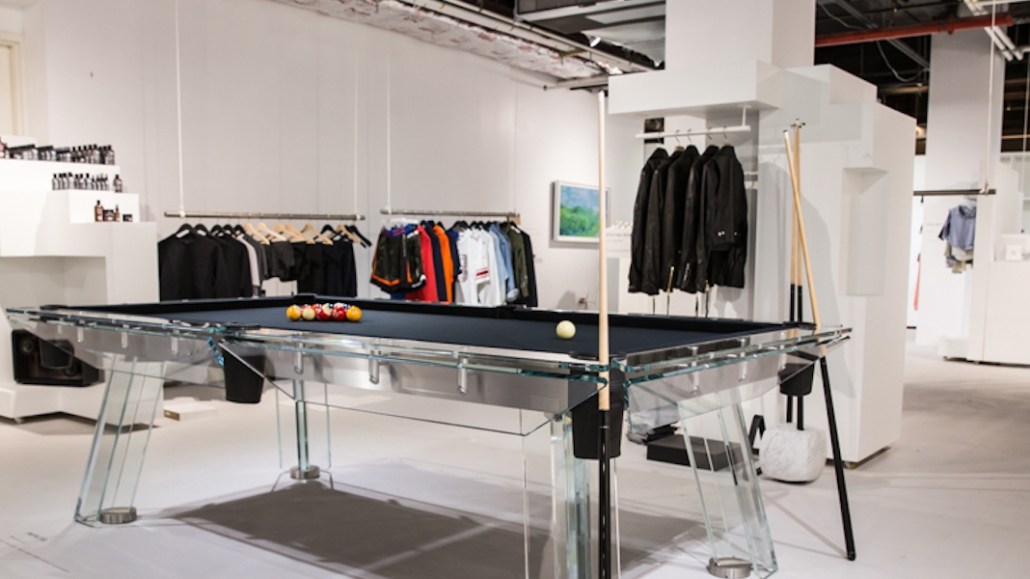
The Digiday retail briefing is a weekly newsletter from Digiday that will take you behind the scenes of an industry in upheaval. To get this in your inbox, sign up here.
The pop-up bubble may be about to burst.
The real estate model emerged as a sensible middle ground for digitally native consumer to test in-store retail. Rather than plunking down the investment required for long-lasting store infrastructure and a long-term lease, brands opted to spend less for the short term, throwing together a passable store and opening the doors for a period of time. When it’s all temporary, nothing has to be perfect.
But as online brands saddle up to establish viable businesses, permanence is again gaining appeal. Turns out, customers appreciate it when they can count on a store location still being there at the same time next year.
“We did so many temporary stores – about 20 – that we got to a point where we realized we were spending so much time and energy on things like negotiating leases, dealing with construction, installing light fixtures, setting up WiFi, hiring staff, just to shut it all down and start from scratch again. That takes away from the important things, like customer experience,” said Joseph Einhorn, the founder of the social-selling marketplace Fancy, which opened its first permanent store in New York on Sunday. “Temporary pop-ups were barely lucrative. You get in, you get out, and it serves a purpose, but permanent retail brings an enduring piece of business to our strategy.”
Einhorn said that Fancy’s first permanent store, which is on Bond Street in New York’s Nolita neighborhood, is more cost-efficient over time, since it removes the initial costs of launching pop-up stores over and over. According to Melissa Gonzalez, the founder of experiential retail consultancy The Lionesque Group, pop-ups are no small undertaking, even if they appear to be a leaner investment than permanent retail at the outset. Not only is there a budget involved to launch, but the pressure is on to have the systems in place to gather all customer data and touchpoints from a pop-up, in order to get lasting information from a store once it’s closed. Because that’s what’s appealing about pop-ups in the first place: Learning more about customers than you can online in different locations.
But as the question around whether or not digitally native brands even need stores stops being raised (the answer: they do), the pop-up makes less sense as a long-lasting strategy.
“Stores aren’t a temporary strategy. Use customer data to figure out where to open, find a space with flexible lease terms, and then invest in it for the long term,” said Gonzalez. “That’s the new retail playbook.”
Overheard
“Experiential marketing plays a critical role in fashion retail. It’s a incredible way to build loyalty and connect with customers on a level beyond just buying clothes. If you’re not creating interesting experiences at your physical stores, people just won’t come.” — J.D. Ostrow, CMO, Theory
What we’ve covered
Wayfair is creating digital experiences on its website and app that include personalized recommendations based on what the retailer knows about the customer, and visualization capabilities that are as close as possible to a physical in-store experience or having a designer visit a customer’s home.
Go inside Store No. 8, which is one component of Walmart’s bigger innovation strategy to prepare for a future customer experience that will be increasingly digital and mobile. Walmart, like other retailers, is investing in various technologies through Store No. 8, Walmart Labs, its in-house innovation lab, and through acquisitions like Jet.com. and Flipkart. Casting a wide net in tech investments is important for retailers as they determine their recipe for differentiating from competitors.
The retail apocalypse may have a silver lining after all: Malls are now being repurposed as startup incubation hubs. Mall operators are teaming up with startup programs to offer startups co-working spaces, networking and mentorship possibilities. In November, the Pennsylvania Real Estate Trust and incubator 1776 will open a retail incubator inside the Cherry Hill Mall, and for the past three years, Westfield has been using space in the Westfield San Francisco Centre shopping mall to connect startups with member retailers.
Adam Goldenberg, the co-founder and co-CEO of Fabletics and TechStyle, wants to fast-track his biggest brand’s growth rate: His goal is to double Fabletics’ business over the next three years. To do that, Fabletics is speeding up and improving its design and merchandising strategy, plotting expansion in more countries, and opening 75 stores globally, bringing the total to 100 locations.
By the numbers
CPC Strategy’s 2018 report on influencer marketing asked 1,5000 Americans to share their thoughts on the space.
- 32 percent said they never trust paid recommendations
- 40 percent can’t tell when an influencer’s post is sponsored by a brand
- 28 percent said a paid promotion feels out of place in their news feed.
- 68 percent said they were most likely to hear about a new product on Facebook, while 11 percent said Instagram.
More in Marketing

How marketers rank this year’s generative AI image, video tools
Digiday’s 2025 agency generative AI report card explores the winners and losers of the generative AI landscape.

In memoriam: Brands we lost in 2025
Digiday Media staff rounded up some of the most notable brand names we lost in 2025, like Joann and Rite Aid.

Pandora is betting on AI agents to scale service and emotional selling during the peak holiday season
Pandora is using AI agents to scale customer service and replicate emotional in-store selling online, just as peak season puts pressure on margins and teams.








